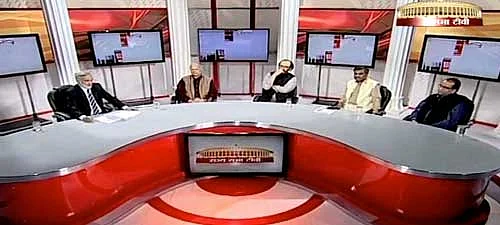Channel Surf – Rajya Sabha TV
Media Manthan churns up non-stormy media debates in their antiquated teacup.


Support Independent Media
The media must be free and fair, uninfluenced by corporate or state interests. That's why you, the public, need to pay to keep news free.
ContributeWith the media marathon that is always running on our screens it’s a little surprising that no news channel ever considers turning the lens inward on themselves – or maybe they do, but then think better of it. After all, we all know the proponents of free press rarely like to be placed under the scanner, least of all their own. It is perhaps not that surprising then that a show which talks about media issues is seen on the relatively less viewed Rajya Sabha TV – the television channel of the upper house of the Parliament.
Media Manthan is hosted by the channel’s Executive Editor, Urmilesh – who reportedly quit this week – and is aired on Saturdays at 8:30 pm. The show reminds one of the early days of news channels when discussions remained discussions and not shouting matches and there was at least some amount of decorum maintained in TV debates. Keeping in mind the Rio Summit, last Saturday’s show focused on the reportage of science and environment by the news media. The show usually has reporters and media critics on its panel. And the panel discussing environment reporting had NDTV’s Science Editor, Pallav Bagla and Hindustan Times reporter, Chetan Chauhan along with an environmental activist. It was a clean, low decibel level debate which carried on at a slow pace. After watching that episode you wouldn’t be blamed for believing that no one ever raises their voice on Media Manthan.
That is obviously not the case. By the end of an earlier episode on Dalits in the Media, the panelists – Prabhu Chawla, Anil Chamadia and a few others – were shouting at each other in the attempt to prove that they were free from caste-bias. But just one loud argument, that too right at the end of a 30-minute show! It seemed like a perfect world.
What also makes Media Manthan interesting to watch it that it’s almost an anachronism. With external panelists being connected not by video link, but over the phone. While their photograph is shown on the screen along with that of their city on the map – just like the good old days of Doordarshan News. Although you could argue, that the BBC still does so. But that’s usually when their reporters are stuck in conflict zones and satellite uplinks aren’t possible. It’s an aberration usually, not the norm. Unlike on Media Manthan.
While the calm and easy-on-the-ear manner in which the debates are carried out is a welcome change, all is not hunky-dory with the show. For one, though the anchor seems to have a strong command over Hindi, his pronunciation of some syllables is not correct. Words like “coverage” and “wajah” are pronounced “coveraze” and “wazah”. You could say I’m splitting hairs, but it’s strange to hear these pronunciations repeated, especially since Hindi is the language of discussion on the channel. Two, the discussion does seem a little dull sometimes. A little lagubrious and sedentary. But this could be because we are used to the pace of today’s news reportage and debates. And three, the strip carrying the names and designations of various speakers also doesn’t appear on the screen often enough. So if you tune into the channel a little after the debate has begun, you might have no idea who the panelists are till the end.
In the episode on Dalits in Media, one of the panelists had brought along some of his research with him to discuss on the show. The details and figures that he was quoting though, should have been part of the show’s research itself. And that’s something I noticed across episodes. That although every episode starts with a package on the kind of media issue they are going to take up on the show, the anchor himself seems a little unprepared on each of the subjects.
Media Manthan’s strengths and weaknesses per episode vary according to the panelists they’ve invited. When erudite media personalities are on the panel, it becomes a good episode, like the one on Celebrity Culture in Media. The likes of Ashutosh from IBN7 and Siddharth Varadarajan from The Hindu placed some interesting points in front of the panel. But on other occasions, some panelists almost seem like all they are there to do is complain about how things have changed for the worse in media and journalism – without realising that they are also a part of the problem.
The ‘Manthan’ in the show’s name means churning. The media industry is certainly going through a phase where much churning is required. The show should definitely make the most of being one of the rare programmes which is actually turning an eye on the media. While I am firmly rooting for the show, I believe it still hasn’t explored its full potential to take itself to a whole new level to fill this vacuum that currently exists on Indian television.


Power NL-TNM Election Fund
General elections are around the corner, and Newslaundry and The News Minute have ambitious plans together to focus on the issues that really matter to the voter. From political funding to battleground states, media coverage to 10 years of Modi, choose a project you would like to support and power our journalism.
Ground reportage is central to public interest journalism. Only readers like you can make it possible. Will you?
